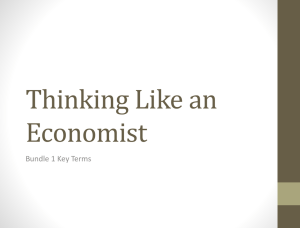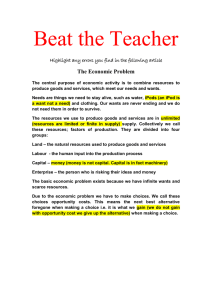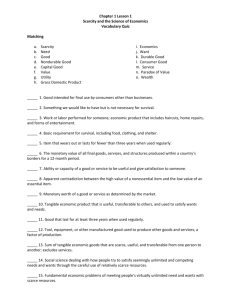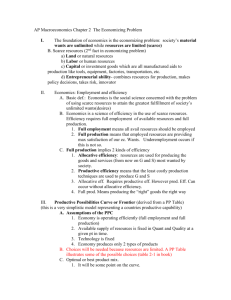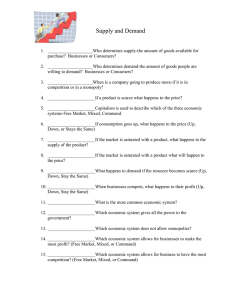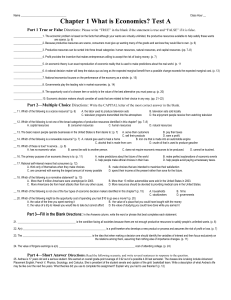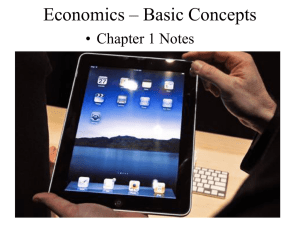Chapter 2 Economizing problem The Foundation of Economics
advertisement
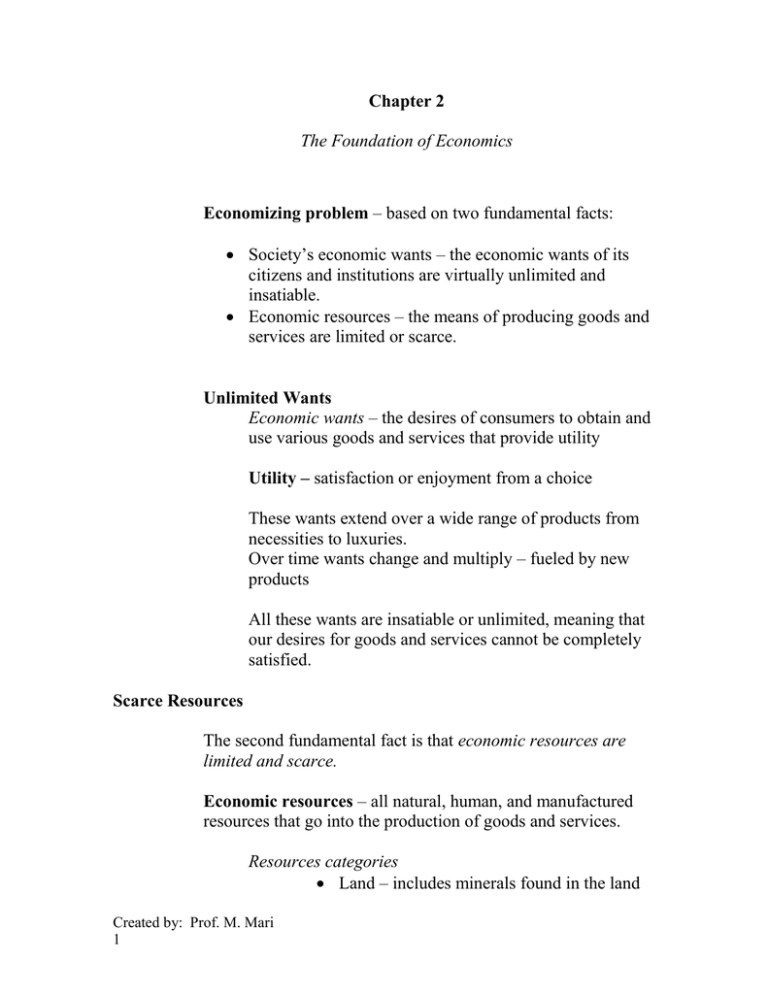
Chapter 2 The Foundation of Economics Economizing problem – based on two fundamental facts: Society’s economic wants – the economic wants of its citizens and institutions are virtually unlimited and insatiable. Economic resources – the means of producing goods and services are limited or scarce. Unlimited Wants Economic wants – the desires of consumers to obtain and use various goods and services that provide utility Utility – satisfaction or enjoyment from a choice These wants extend over a wide range of products from necessities to luxuries. Over time wants change and multiply – fueled by new products All these wants are insatiable or unlimited, meaning that our desires for goods and services cannot be completely satisfied. Scarce Resources The second fundamental fact is that economic resources are limited and scarce. Economic resources – all natural, human, and manufactured resources that go into the production of goods and services. Resources categories Land – includes minerals found in the land Created by: Prof. M. Mari 1 Capital – includes all manufactured aids used in producing consumer goods and services. o Such as tools, machinery, equipment, factory, storage, transportation, and distribution facilities. o The process of producing and purchasing capital goods is known as investment o Capital goods differ from consumer goods in that consumer goods satisfy wants directly, while capital goods do s indirectly by aiding the production of consumer goods. o Capital is not money but real goods o Labor – a broad term for all the physical and mental talents of individuals available and usable in producing goods and services. o Entrepreneurial ability - Takes the initiative in combining the resources of land, capital, and labor to produce a good or service - Makes basic business policy decisions - Is an innovator - Risk bearer Called Factors of Production o Used to produced goods and services Resources payments Land – rents Capital – interest Labor – wages Entrepreneurial income – profits Created by: Prof. M. Mari 2 Relative Scarcity The fours types of economic resources or factors of production or inputs have one significant characteristic in common: They are scarce or limited in supply Employment and Efficiency Economics is the social science concerned with the problem of using scarce resources to attain the maximum fulfillment of society’s unlimited wants. Concerned with doing the best with what we have Full employment – to realize the best use of scarce resources, a society must achieve both full employment and full production. Full employment means that the use of all available resources. o No workers should be out of work if they are willing and able to work. Remember all those willing and able to work o Nor should capital equipment or arable land sit idle The employment of all available resources is not enough to achieve efficiency. Full production must also be realized. Full production – all employed resources should be used so that they provide maximum possible satisfaction of our material wants. If we fail to use all resources then we are underemployed. Two types of efficiency o Productive efficiency – is the production of any particular mix of goods and services in the least costly way. o Allcative efficiency – is the production of that particular mix of goods and services most wanted by society. Created by: Prof. M. Mari 3 o This means apportioning limited resources among firms and industries in such a way that society obtains the combination of goods and services it wants the most. Production Possibilities Table Assumptions 1. Full employment and productive efficiency 2. Fixed resources 3. Fixed technology 4. Two goods a. Consumer goods b. Capital goods Society must choose among alternative It is a list of the different combination of two products, which can be produced, with a specific set of resources. Good A 0 1 2 3 4 Good B 10 9 7 4 0 At any point in time, an economy achieving full employment and productive efficiency must sacrifice some of one good to obtain more of another good. Scarce resources prohibit scarce an economy from having more of both good. Created by: Prof. M. Mari 4 Law of increasing Opportunity Cost Because resources are scarce relative to the virtually unlimited wants they can be used to satisfy, people must choose among alternatives. Opportunity cost – the amount of other products that must be forgone or sacrificed to obtain 1 unit of a specific good When more of a good is produced the greater is the opportunity cost of producing that good o Why? Economic resources are not completely adaptable to alternative uses Allocative Efficiency Revisited Resources are being efficiently allocated to any product when the marginal benefit and marginal cost of its output are equal . MB = MC Created by: Prof. M. Mari 5 Unemployment, Growth, and the Future Unemployment and Productive inefficiency o Producing inside the curve. o Inefficient use of resources and unemployment occur o We are producing at less than each alternative shown on the table o A move toward full employment and productive efficiency would yield a greater output of one or both parties Growing economy o When we drop the assumption that the quantity and quality of resources and technology are fixed, the production possibilities curve shifts positions that is, the potential maximum output of the economy changes. o Increases in Resource Supplies They can and do change over time Examples The net result of these increased supplies of the factors of production is the ability to produce more of both goods Society will have achieved economic growth o Advances in Technology Adavancing technology brings both new and better goods and improved ways of producing them Shifts the curve outward o Economic growth occurs It is the ability to produce a larger total output Increase in resources or change in technology While a static, no growth economy must sacrifrice some of one product in order to get more of another; a dynamic, growing economy can have larger quantities of both products. Created by: Prof. M. Mari 6 Qualification: International Trade Production possibilities analysis implies that an individual nation is limited to the combinations of output indicated by its production possibilities curve Must be modified when international trade occurs International specialization means directing domestic resources to output that a nation is highly efficiency at producing International trade involves the exchange of these goods for goods produced abroad. Specialization and trade enable a nation to get more of a desired good at less sacrifice of some other good Economic Systems – A particular set of institutional arrangements and a coordinating mechanism to respond to the economizing problem. Economic systems differ: Who owns factors of production The method used to coordinate and direct economic activity. Pure Capitalism or market system Each participant acts in his or her own self interest; each individual or business seeks to maximize its satisfaction or profit through its own decisions regarding consumption or production. Private ownership of resources Coordinates economic activity through markets Goods and services are produced and resources are supplied by whoever is willing and able to do so Competition among independently acting buyers and sellers of each product and resource. No government intervention Laissez-faire Created by: Prof. M. Mari 7 Command Economy Public ownership of virtually all property resources and economic decision making through central economic planning. Communism Government owns all the resources Planning board determines production goals for each enterprise and specifies the amount of resources to be allocated to each enterprise so that it can reach its production goals Mixed economy Government actively participates in the economy by promoting economic stability and growth. Private and government owned resources Some planning and regulation Called socialism Circular Flow Model Resource market - the place where resources or the services of resource suppliers are bought and sold Product market – the place where goods and services produced by business are bought and sold Created by: Prof. M. Mari 8
